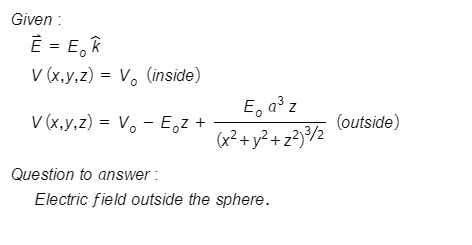When an uncharged conducting sphere of radius a is placed at the origin of an xyz coordinate system that lies in an initially uniform electric field = E0 , the resulting electric potential is V (x,y,z) = V0 for the points inside the sphere and V (x,y,z) = V0 − E0z + E0a3z (x2 + y2 + z2)3/2 for points outside the sphere, where V0 is the (constant) electric potential on the conductor. Use this equation to determine the x, y, and z components of the resulting electric field in the following regions. (Use the following as necessary: x, y, z, a, and E0.) (a) inside the sphere (b) outside the sphere Note: I already solved part a. I need help with part b. Look at the image for the full problem
When an uncharged conducting sphere of radius a is placed at the origin of an xyz coordinate system that lies in an initially uniform electric field = E0 , the resulting electric potential is V (x,y,z) = V0 for the points inside the sphere and V (x,y,z) = V0 − E0z + E0a3z (x2 + y2 + z2)3/2 for points outside the sphere, where V0 is the (constant) electric potential on the conductor. Use this equation to determine the x, y, and z components of the resulting electric field in the following regions. (Use the following as necessary: x, y, z, a, and E0.) (a) inside the sphere (b) outside the sphere Note: I already solved part a. I need help with part b. Look at the image for the full problem
College Physics
11th Edition
ISBN:9781305952300
Author:Raymond A. Serway, Chris Vuille
Publisher:Raymond A. Serway, Chris Vuille
Chapter1: Units, Trigonometry. And Vectors
Section: Chapter Questions
Problem 1CQ: Estimate the order of magnitude of the length, in meters, of each of the following; (a) a mouse, (b)...
Related questions
Question
When an uncharged
V (x,y,z) = V0 − E0z +
| E0a3z |
| (x2 + y2 + z2)3/2 |
for points outside the sphere, where V0 is the (constant) electric potential on the conductor.
Use this equation to determine the x, y, and z components of the resulting electric field in the following regions. (Use the following as necessary: x, y, z, a, and E0.)
(a) inside the sphere
(b) outside the sphere
Note: I already solved part a. I need help with part b. Look at the image for the full problem.

Transcribed Image Text:When an uncharged conducting sphere of radius a is placed at the origin of an xyz coordinate system that lies in an initially uniform electric field E = E, k, the resulting electric potential is
0.
(x,y,z) = V. for the points inside the sphere and
V (x,y,z) = Vo
Eoz +
Ega z
(x2 + y? + z?)3/2
for points outside the sphere, where V, is the (constant) electric potential on the conductor.
Use this equation to determine the x, y, and z components of the resulting electric field in the following regions. (Use the following as necessary: x, y, z, a, and E.)
(a) inside the sphere
E = 0
Ey
E, = 0
(b) outside the sphere
Ex =0
Ey =
E =
Need Help?
Read It
Submit Answer
Expert Solution
Step 1

Trending now
This is a popular solution!
Step by step
Solved in 4 steps with 4 images

Knowledge Booster
Learn more about
Need a deep-dive on the concept behind this application? Look no further. Learn more about this topic, physics and related others by exploring similar questions and additional content below.Similar questions
Recommended textbooks for you

College Physics
Physics
ISBN:
9781305952300
Author:
Raymond A. Serway, Chris Vuille
Publisher:
Cengage Learning

University Physics (14th Edition)
Physics
ISBN:
9780133969290
Author:
Hugh D. Young, Roger A. Freedman
Publisher:
PEARSON

Introduction To Quantum Mechanics
Physics
ISBN:
9781107189638
Author:
Griffiths, David J., Schroeter, Darrell F.
Publisher:
Cambridge University Press

College Physics
Physics
ISBN:
9781305952300
Author:
Raymond A. Serway, Chris Vuille
Publisher:
Cengage Learning

University Physics (14th Edition)
Physics
ISBN:
9780133969290
Author:
Hugh D. Young, Roger A. Freedman
Publisher:
PEARSON

Introduction To Quantum Mechanics
Physics
ISBN:
9781107189638
Author:
Griffiths, David J., Schroeter, Darrell F.
Publisher:
Cambridge University Press

Physics for Scientists and Engineers
Physics
ISBN:
9781337553278
Author:
Raymond A. Serway, John W. Jewett
Publisher:
Cengage Learning

Lecture- Tutorials for Introductory Astronomy
Physics
ISBN:
9780321820464
Author:
Edward E. Prather, Tim P. Slater, Jeff P. Adams, Gina Brissenden
Publisher:
Addison-Wesley

College Physics: A Strategic Approach (4th Editio…
Physics
ISBN:
9780134609034
Author:
Randall D. Knight (Professor Emeritus), Brian Jones, Stuart Field
Publisher:
PEARSON